After the Fox
6.6 /10 1 Votes
71% Rotten Tomatoes Duration Country ItalyUnited Kingdom | 6.5/10 IMDb 6/10 Letterboxd Genre Comedy, Crime Language EnglishItalian | |||||||||||||||||||||||||||||||||
 | ||||||||||||||||||||||||||||||||||
Release date 1966 (1966) Cast (Aldo Vanucci / Federico Fabrizi), (Tony Powell), (Gina Vanucci aka "Gina Romantica"), (Harry) Similar movies Escape from Alcatraz , Anaconda , Kelly's Heroes , Man Bites Dog , City Slickers II: The Legend of Curly's Gold , Touchez Pas au Grisbi Tagline Watch your girl, guard your gold, hold your jewels ...the fox is loose! | ||||||||||||||||||||||||||||||||||
After the Fox (Italian: Caccia alla volpe) is a 1966 British–Italian comedy film directed by Vittorio De Sica and starring Peter Sellers, Victor Mature and Britt Ekland. The screenplay is in English, by Neil Simon and De Sica's longtime collaborator Cesare Zavattini.
Contents
- Peter sellers crazy film director scene after the fox
- Plot
- Production
- Release
- Influence
- Caccia alla volpe after the fox 1966
- References
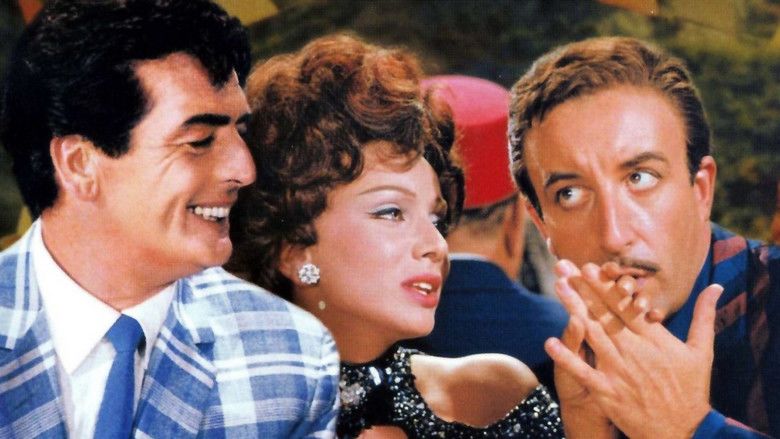
Despite its notable credits, the film was poorly received when it was released. It has since gained a cult following for its numerous in-jokes skewering pompous directors, including Cecil B. DeMille, John Huston (who appears briefly in the movie, portraying Moses for De Sica in a film shoot within the film), Federico Fellini, Michelangelo Antonioni, and De Sica himself, vain film stars, their starstruck audiences, and pretentious film critics. The film was remade in 2010 in Hindi as Tees Maar Khan.
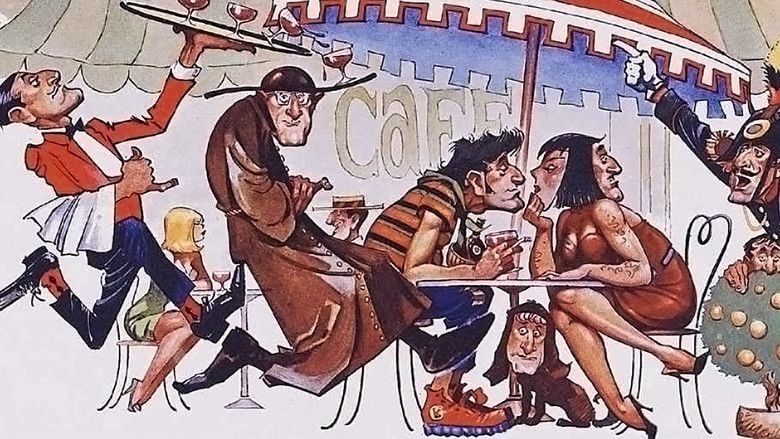
Peter sellers crazy film director scene after the fox
Plot
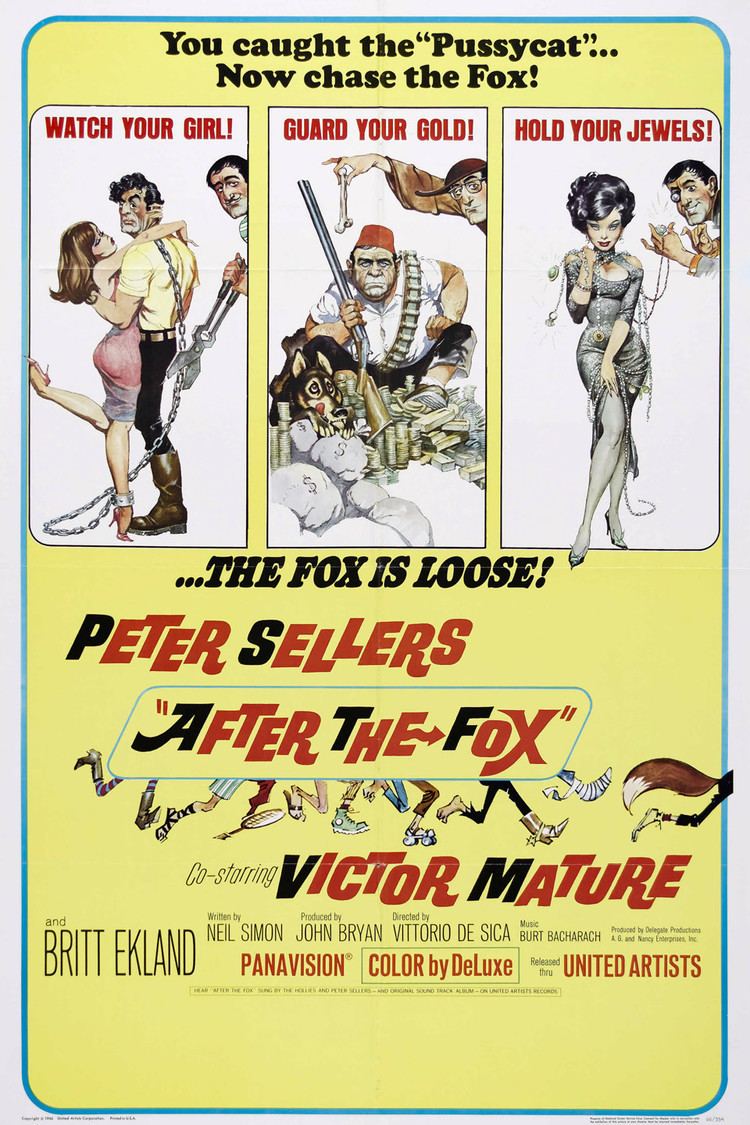
The story begins outside Cairo where Okra (Akim Tamiroff), using a bikini-clad accomplice (Maria Grazia Buccella) as a distraction, hijacks $3 million in gold bullion. The thieves need a way to smuggle the two tons of gold bars into Europe. There are only four master criminals considered capable of smuggling the gold, but each is ruled out: a Frenchman is so crippled that he can barely move his wheelchair; an Irishman is so nearsighted that he is arrested after trying to hold up a police station instead of a bank; a German is so fat he can barely get through a door; and an Italian, Aldo Vanucci (Peter Sellers), also known as The Fox, a master criminal with a talent for disguise, is in prison.

Vanucci knows about the smuggling contract but is reluctant to accept it because he does not want to disgrace his mother and young sister, Gina (Britt Ekland). However, when his three sidekicks inform him that Gina has grown up and does not always come home after school, an enraged, over-protective Vanucci vows to escape. He succeeds by impersonating the prison doctor and convincing the guards that Vanucci has tied him up and escaped. The guards capture the doctor and bring him face to face with Vanucci, who flees with the aid of his gang. Vanucci returns home where his mother tells him that Gina is working on the Via Veneto. He takes this to mean that Gina is a prostitute. Disguised as a priest, Aldo sees Gina, who is provocatively dressed, flirting and kissing a fat, middle-aged man. Aldo attacks the man, but it turns out that Gina, who aspires to be a movie star, is merely acting in a low-budget film. Aldo’s actions cost her the job, but he realizes that the smuggling contract will make his family’s life better. He makes contact with Okra and agrees to smuggle the gold into Italy for half of the take. Meanwhile, two policemen are constantly on Vanucci’s trail, and he uses several disguises and tricks to throw them off. After seeing a crowd mob over-the-hill American matinee idol Tony Powell (Victor Mature), it strikes Vanucci that movie stars and film crews are idolized and have free rein in society. This idea forms the basis of his master plan.
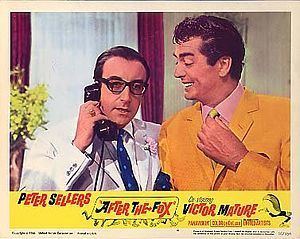
Vanucci poses as an Italian neo-realist director named Federico Fabrizi. He plans to bring the gold ashore in broad daylight as part of a scene in an avant-garde film. To give the picture an air of legitimacy, he cons the vain Tony Powell to star in the film, blatantly titled The Gold of Cairo — a play on The Gold of Naples, a film De Sica directed in 1954. Powell’s agent, Harry (Martin Balsam) is suspicious of Fabrizi, but his client wants to do the film. Fabrizi enlists the starstruck population of Sevalio, a tiny fishing village, to unload the shipment. However, when the boat carrying the gold is delayed, Fabrizi must actually shoot other scenes for his faux film to keep up the ruse. The ship finally arrives and the townspeople unload the gold, but Okra double-crosses Vanucci and, using a movie smoke machine for cover, drives off with all of the gold. A slapstick car chase ensues, ending with Okra, Vanucci and the police crashing into each other. Vanucci, Tony Powell, Gina, Okra, and the villagers are accused of being co-conspirators, and Vanucci’s "film" is shown as evidence in court. An Italian film critic leaps to his feet and proclaims the disjointed footage to be a masterpiece. Vanucci suffers a crisis of conscience and confesses his guilt in court, thereby vindicating the villagers, but proclaiming that he will escape from prison once again.
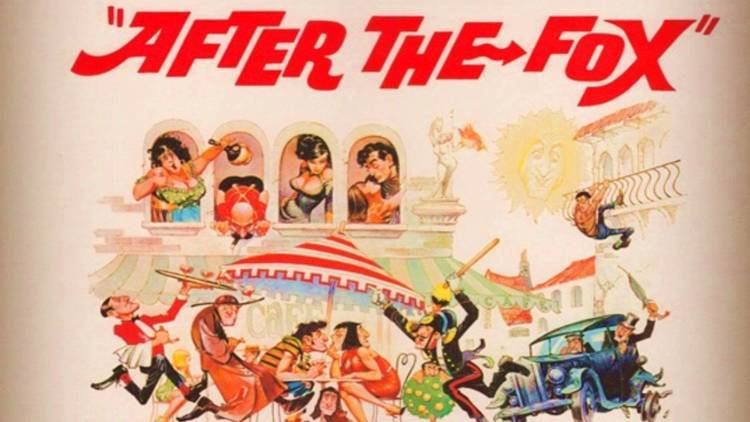
The film's final scene shows Vanucci escaping from prison by impersonating the prison doctor again. This time, however, he ties the doctor up and walks out of the prison in his place. When he attempts to remove the fake beard that is part of his disguise, he discovers that the beard is real, and realizes that the "wrong man" has escaped from prison.
Production

This was Neil Simon's first screenplay. At the time, he had three hit shows running on Broadway — Little Me, Barefoot in the Park and The Odd Couple. Simon said that he originally wanted to write a spoof of art house films such as Last Year at Marienbad and Michelangelo Antonioni's films, but the story evolved into the idea of a film-within-a-film. Aldo Vanucci brings to mind the fast-talking cons of Phil Silvers and the brilliant dialects of Sid Caesar. This is probably no coincidence, since Simon wrote for both on television.

In his 1996 memoir Rewrites, Simon recalled that an agent suggested Peter Sellers for the lead, while Simon preferred casting "an authentic Italian" such as Marcello Mastroianni or Vittorio Gassman. Sellers loved the script, however, and it was he who asked Vittorio De Sica to direct.
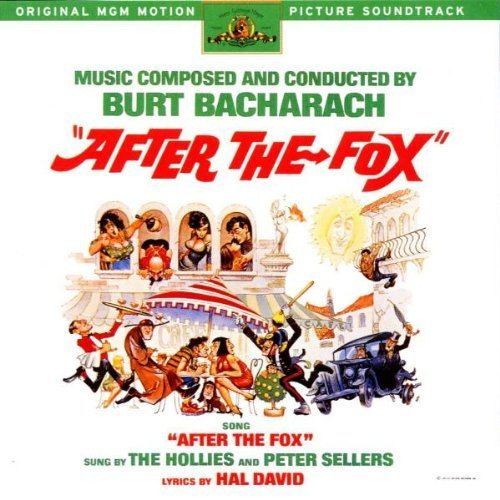
De Sica's interest in the project surprised Simon, who at first dismissed it as a way for the director to support his gambling habit. But De Sica said he saw a social statement to be made, namely how the pursuit of money corrupts even the arts. Simon believed De Sica also relished the opportunity to take potshots at the Italian film industry. De Sica insisted that Simon collaborate with Cesare Zavattini. Since neither spoke the other's language, the two writers worked through interpreters. Simon wrote, "He had very clear, concise, and intelligent comments that I could readily understand and agree with." Still, Simon worried that inserting social statements into what he considered a broad farce would not do justice to either. Yet, After The Fox does touch on themes found in De Sica's earlier work, namely disillusionment and dignity.
Peter Sellers told the press that his main reason for doing the film was the chance to work with Vittorio De Sica. After the Fox was the first film produced by Sellers' new Brookfield production company, which he formed in partnership with John Bryan, a former production designer. It was also their last production, as Sellers and Bryan had a rift over De Sica. Sellers complained that the director "thinks in Italian, I think in English", and wanted De Sica replaced. But Bryan resisted for financial and artistic reasons. De Sica, meanwhile, grew impatient with his petulant star and did not like Sellers' performance or Simon's screenplay.
Victor Mature, who had retired from films five years earlier, was lured back to the screen by the prospect of parodying himself as Tony Powell. Mature was always a self-effacing star who had no delusions about his own work. At the height of his fame he applied for membership in the Los Angeles Country Club but was told that the club did not accept actors. He replied: "I'm not an actor — and I've got 64 films to prove it!" A clip from Mature's 1949 film Easy Living (in which he plays an aging football star) appears in the film. He agreed to make the film after a personal call from Sellers.
According to Neil Simon, Sellers demanded that his wife, Britt Ekland, be cast as Gina, the Fox's sister. Ekland's looks and accent were wrong for the role, but to keep Sellers happy De Sica acquiesced. Still, Simon recalled, Ekland worked hard on the film. Sellers and Ekland made one other film together, The Bobo (1967).
Also featured are Akim Tamiroff as Okra, the mastermind of the heist in Cairo; Martin Balsam as Tony's agent, Harry; Maria Grazia Buccella as Okra's voluptuous accomplice; Lydia Brazzi as Mama Vanucci; and Lando Buzzanca as the chief of police in Sevalio. Simon recalled that the Italian supporting cast learned their English lines phonetically. Tamiroff had been working on and off for Orson Welles filming Don Quixote, playing Sancho Panza. That film was never finished. Buccella was a former Miss Italy (1959) and placed third in the Miss Europe pageant. She had been considered for the role of Domino in Thunderball. The wife of actor Rossano Brazzi, Lydia Brazzi was hand-picked by De Sica for the role of the Fox's mother, over her protestation that she was not an actress.
The budget for the film was $3 million, which included the construction of an exact replica of Rome's most famous street, the Via Veneto, on the Cinecittà lot, and location filming in the village of Sant' Angelo on Ischia in the Bay of Naples. The Sevalio sequences were shot during the height of the tourist season. Reportedly the villagers of Sant' Angelo were so busy accommodating tourists that they had no time to appear as extras in the film. The extras were brought in from a neighboring village.
Simon lamented that De Sica insisted on using his own film editors, two individuals who did not speak English and thus did not understand the jokes. The film was later re-cut in Rome by one of John Huston's favorite film editors, Russell Lloyd, but Simon believes more funny bits "are lying in a cutting room in Italy". (Apparently there was a scene where Vanucci impersonated one of the Beatles.)
The voices and accents of the Italian comic actors were dubbed in London, mainly by Robert Rieti, and edited in Rome by Malcolm Cooke, who had been a post-sync dialogue editor on Lawrence of Arabia.
Simon summed up his opinion of the film: "To give the picture its due, it was funny in spots, innovative in its plot, and was well-intentioned. But a hit picture? Uh-uh ... Still today, After the Fox remains a cult favorite."
Burt Bacharach composed the score, and with lyricist Hal David wrote the title song for the film. For the Italian release, the score was composed by Piero Piccioni. The title song "After the Fox" was recorded by The Hollies with Sellers in August 1966 and released by United Artists as a single (b/w "The Fox-Trot").
Release
After the Fox was released in Great Britain, Italy, and the United States in December 1966.
As part of a publicity barrage, United Artists announced that it had signed Federico Fabrizi to direct three films. The story was to be planted in the trade papers and then appear in general newspapers, with Sellers available for telephone interviews in character as Fabrizi. But the editors of Daily Variety recognized the fictional name immediately and spoiled the gag.
The film received mixed reviews. Critic Bosley Crowther summed up his review in The New York Times: "It's pretty much of a mess, this picture. Yes, you'd think it was done by amateurs." The Variety reviewer thought "Peter Sellers is in nimble, lively form in this whacky comedy which, though sometimes strained, has a good comic idea and gives the star plenty of scope for his usual range of impersonations." Opinion continues to be divided. After the Fox is rated 6.5/10 on IMDB, an average of more than 2,500 user ratings. The review aggregator Web site Rotten Tomatoes reported an 83% approval rating with an average rating of 5.7/10, based on six reviews; the Rotten Tomatoes audience score was 68%.
The film has some kinship with What's New Pussycat?, which was released the previous year and also starred Sellers. That film was the first written by Woody Allen who, like Neil Simon, had been a staff writer for Sid Caesar. Even the advertising tagline on the posters and trailer for After The Fox proclaimed, "You Caught The Pussycat ... Now Chase The Fox!". The poster art for both films was illustrated by Frank Frazetta.
Influence
The device in which robbers use a movie set to cover a robbery is also in Woody Allen's Take the Money and Run (1969). In the television series Batman, it is used in the 1968 episode titled "The Great Train Robbery".
The scene in the film where Aldo speaks to Okra through the beautiful Maria Grazia Buccella inspired a similar scene in Austin Powers in Goldmember (2002), in which Austin Powers talks to Foxxy Cleopatra through the Nathan Lane character.
The Bollywood movie Tees Maar Khan (2010) is a remake of After the Fox.
Caccia alla volpe after the fox 1966
References
After the Fox WikipediaAfter the Fox IMDbAfter the Fox Rotten TomatoesAfter the Fox LetterboxdAfter the Fox themoviedb.org
